The Contribution of Sustainable Development Goals and Forest-Related Indicators to National Bioeconomy Progress Monitoring
Abstract
1. Introduction
Objectives
2. Materials and Methods
2.1. Review of National Bioeconomy Strategies and Related Indicators
2.2. Review of Bioeconomy Indicator Projects
2.3. Assignment of Bioeconomy Indicators to the Related SDGs, their Targets, and Indicators and Screening of the National Bioeconomy Strategies for SDG-related Wording
2.4. Comparison with Indicators for Sustainable Forest Management (SFM)
3. Results
3.1. The Bioeconomy and its Derived Relationship with the SDGs
3.1.1. Assignment Peculiarities
- -
- Population growth (indicator for Italy)
- -
- Population 15–65 years (indicator for Italy)
- -
- Types of biotechnology used by firms (indicator for South Africa)
- -
- Number of technology-transfer transactions (indicator for South Africa)
- -
- Sustainability threshold levels for Bioeconomy Technologies (indicator for the Biomonitor Project)
- -
- “Pharmaceutical industry productivity and number of regulatory approvals for health products”, assigned to SDG target 3.3;
- -
- Various innovation indicators, assigned to SDG target 9.5;
- -
- Indicators on climate change mitigation and adaptation such as carbon emissions, carbon sequestration, climate footprint, etc., assigned to SDG target 13.2.
3.1.2. Frequency of Assignment
3.1.3. Different Relevance of the SDGs for National Bioeconomies
3.2. Distribution of Forest-related and other Bioeconomy Indicators
4. Discussion
4.1. Is Progress towards Bioeconomy Strategy Objectives Measured by Using Indicators?
4.2. Contain the Studied National Bioeconomy Strategies Developed and Adopted after 2015 References to the SDGs, their Targets and Indicators?
4.3. As the Forest Sector is One of the Key Sectors for the Development of a Bioeconomy, do the National Bioeconomy Indicators Resemble the Respective Intergovernmental Regional or International Indicators for SFM?
5. Conclusions
5.1. Which SDGs Might Be Included in the Future Bioeconomy Discussion?
5.2. What might be Improved in Sets of National Bioeconomy Indicators to Fit them Better with Bioeconomy-related SDGs, Targets, and Indicators?
- Each objective in the bioeconomy strategy should have at least one indicator for quantification, progress monitoring, and assessment;
- Comprehensive approaches for progress reporting on the bioeconomy should consider all relevant SDG issues;
- If an SDG-related goal is addressed in the bioeconomy strategy, the pool of corresponding SDG indicators should be considered;
- Already existing indicators from SDGs or from indicator sets for sustainable forest management should be integrated to reduce monitoring and reporting burdens;
- National monitoring systems and datasets should be harmonized and streamlined with global initiatives and international data requirements for SDGs and forest monitoring (e.g., UNECE, FAO, EUROSTAT, EC JRC, FOREST EUROPE) to allow comparability. Measure once, store in intersectoral databases and use manifold;
Author Contributions
Funding
Acknowledgments
Conflicts of Interest
Abbreviations
| ASEAN | Association of South-East Asian Nations |
| BE | Bioeconomy |
| BES | Bioeconomy Strategy |
| BOKU | University of Natural Resources and Life Sciences, Vienna |
| EC JRC | Joint Research Centre of the European Commission |
| EEA | European Environment Agency |
| EFI | European Forest Institute |
| EU | European Union |
| EUROSTAT | Statistical Office of the European Commission |
| FAO | Food and Agriculture Organization of the United Nations |
| FE | FOREST EUROPE |
| FOREST EUROPE | The brand name of the Ministerial Conference on the Protection of Forests in Europe |
| FRA | FAO Global Forest Resources Assessment |
| GDP | Gross Domestic Product |
| GERD | Gross Expenditure on Research and Development |
| GMO | Genetically Modified Organism |
| GVA | Gross Value Added |
| Ind. | Indicator |
| IPR | Intellectual Property Rights |
| ITTO | The International Tropical Timber Organization |
| IUFRO | International Union of Forest Research Organizations |
| LFCC | Low Forest Cover Countries |
| Luke | Natural Resources Institute Finland |
| MP | Montréal Process |
| R&D | Research and Development |
| SDG | Sustainable Development Goal of the United Nations |
| SFM | Sustainable Forest Management |
| UN | United Nations |
| UNECE | United Nation Economic Commission for Europe |
| USA | United States of America |
Appendix A
| Country and Reference | Year | No. of Ind. | List of Indicators—As Listed in the National Bioeconomy Strategies |
|---|---|---|---|
| USA [25] | 2012 | 4 | Revenues from genetically modified plants and microbes; Pharmaceutical industry productivity; Employment and putput by industry; R&D costs |
| South Africa [46] | 2013 | 18 | Number of publications and citations in high impact journals per capita; Size of bio-innovation workforce as percentage of science and technology workforce; Number of research chairs, centres of excellence, technology platforms and multi-disciplinary research and development programmmes supported; Bio-economy research and development as a percentage of GERD; Number of patents granted; Number of collaborative product development partnerships; Availability of technology development and assimilation infrastructure; Number of technology-transfer transactions; Availability of incubation facilities of bioinnovation firms; Number of regulatory approvals for health products; Revenues/sales of life science products, processes and services; Number of field trials with GMO crops; Number of bio-innovation firms, including dedicated bio-innovation firms by sector; Venture capital invested in bio-innovation firms; Technology balance of payment of bioinnovation outputs; Number of joint ventures and strategic alliances between local bio-innovation firms and international partners; Multinational corporations in bio-economy sectors locating research and development facilities locally; Types of biotechnology used by firms |
| Finland [47] | 2014 | 16 | Bioeconomy output; Bioeconomy value added; The number employed; The share of BE employed in the national economy; Raw material inputs; value added to raw material streams; Raw material inputs used; Greenhouse gas emissions avoided; Total use of natural resources; Growth and harvested volumes of standing timber; Growth and harvested volumes of cereal crops; Growth and harvested volumes of fish bag; Endangered species; Urban waste; Ecosystem services; Environmental and resource efficiency |
| Malaysia [48] | 2015 | 5 | Bioeconomy investments; Employment in bioeconomy sectors and estimated yearly income; Revenues of BioNexus Status Companies; R&D spending in bioeconomy; Patent applications |
| Spain [49] | 2016 | 6 main Ind. | Public investment and number of activities; private investment and number of activities; Final Production; Added Value; Employee numbers; Exports. The last four are measured for the sectors and areas of: Agriculture; Food industry; Forestry Products; Industrial chemicals; Pharmaceutical and nutritional by-products; Biofuels; Renewable energy of biological origin; Other rural area services; Processed waste; Sustainability indicators |
| Denmark [50] | 2018 | 9 | Resource productivity; Renewable energy, share of total energy consumption; Production costs (shares of different costs); Experienced quality in transport infrastructure; Production costs (shares of different costs); Proportion of recycling of total waste; Waste treatment; GDP; Domestic material consumption |
| United Kingdom [51] | 2018 | 15 | Annual turnover of the UK industrial biotechnology and bioenergy sectors; Forest cover; Industrial biotechnology funding; Investment in education and skills; Investment in low carbon industrial innovation; Jobs, employment; Number of members of the Industrial Biotechnology Innovation Centre; Number of members of the Networks in Industrial Biotechnology and Bioenergy; Renewable transport fuel; Production of sustainable aviation fuels; Resource productivity; Waste processing and materials recovery market; Waste; Converted household waste (into biofuel) |
| Italy [52] | 2018 | 26 | Agricultural biomass production—import of agricultural biomass; Blue biomass production—import of blue biomass; Forestry biomass production—import of forestry biomass; Waste biomass production—import of waste biomass; Firms in total bioeconomy sectors; Firms in bioeconomy subsectors; Innovative start up in total bioeconomy sectors; Innovative start up in bioeconomy subsectors; Employment in total bioeconomy sectors; Employment in bioeconomy subsectors; Tertiary education; R&D employment in total bioeconomy sectors; R&D employment in bioeconomy subsectors; University courses in bioeconomy sectors; Research Institute in bioeconomy sectors; IPRs (patent, trademark, design) applications in total bioeconomy sectors; IPRs (patent, trademark, design) applications in bioeconomy subsectors; Private R&D expenditure; Public R&D expenditure; Population growth; Population 15–65 years; GDP; Exports of total bioeconomy sectors related goods; Exports of bioeconomy subsectors related goods; Imports of total bioeconomy sectors related goods; Imports of bioeconomy subsectors related goods |
| Country and Reference | Year | No. of Ind. | List of Indicators—As Listed in the Indicator Projects |
|---|---|---|---|
| EFI [40] | 2016 | 12 | Resource use; Resource productivity; Resource and materials efficiency; Water footprint; natural resources index; Share of renewable energy in gross final energy consumption; Indirect land use/embodied land for agriculture and forestry products; Red List Index of threatened species; Carbon footprint of the forest and harvested wood chain (carbon stock changes); Greenhouse gas balance (emissions and sequestration), Employment in forest-based bioeconomy sectors, and contribution to regional employment; Eco-innovation index |
| MontBioeco [12] | 2018 | 30 | Number of employed persons in rural and urban areas; Value added; Contribution to the GDP; Investment in research and innovation for creating jobs and maintaining competitiveness; Export; Import; Production of renewable energy incl. production of biofuels and biogas; Material and waste recycling and recovery rates; Material replacing non-renewable resources (bio-materials); Public financial support and private investments for reducing dependence on non-renewable resources; Investment in research and innovation for reducing dependence on non-renewable resources; Carbon sequestration; Forest carbon emissions/sinks; Greenhouse gas emissions from agriculture; Water area carbon emissions/sinks; Public financial support and private investments for mitigating and adaptation; Investment in research and innovation for mitigating and adapting climate change; Domestic food supply of the food commodities in terms of production, import and stock change; Agricultural products; Fish products; Non-wood forest products; New food products; Public financial support and private investments for reducing dependence on non-renewable resources; Investment in research and innovation for ensuring food security; Land cover; Resource availability; Sustainable resource use; Environmental protection; Public financial support and private investments for ecosystem services; Investment in research and innovation for managing natural resources sustainably. |
| Biomonitor [39] | 2019 | 25 | Availability of food; Access to food; Utilization; Stability; Sustainability threshold levels for bioeconomy technologies; Biodiversity; Land cover; Primary Biomass production; Sustainable resource use; Bio-energy replacing non-renewable energy; Bio-material replacing non-renewable resources; Biomass self-sufficiency rate; Material use efficiency; Certified bio-based products, Greenhouse gas emissions |
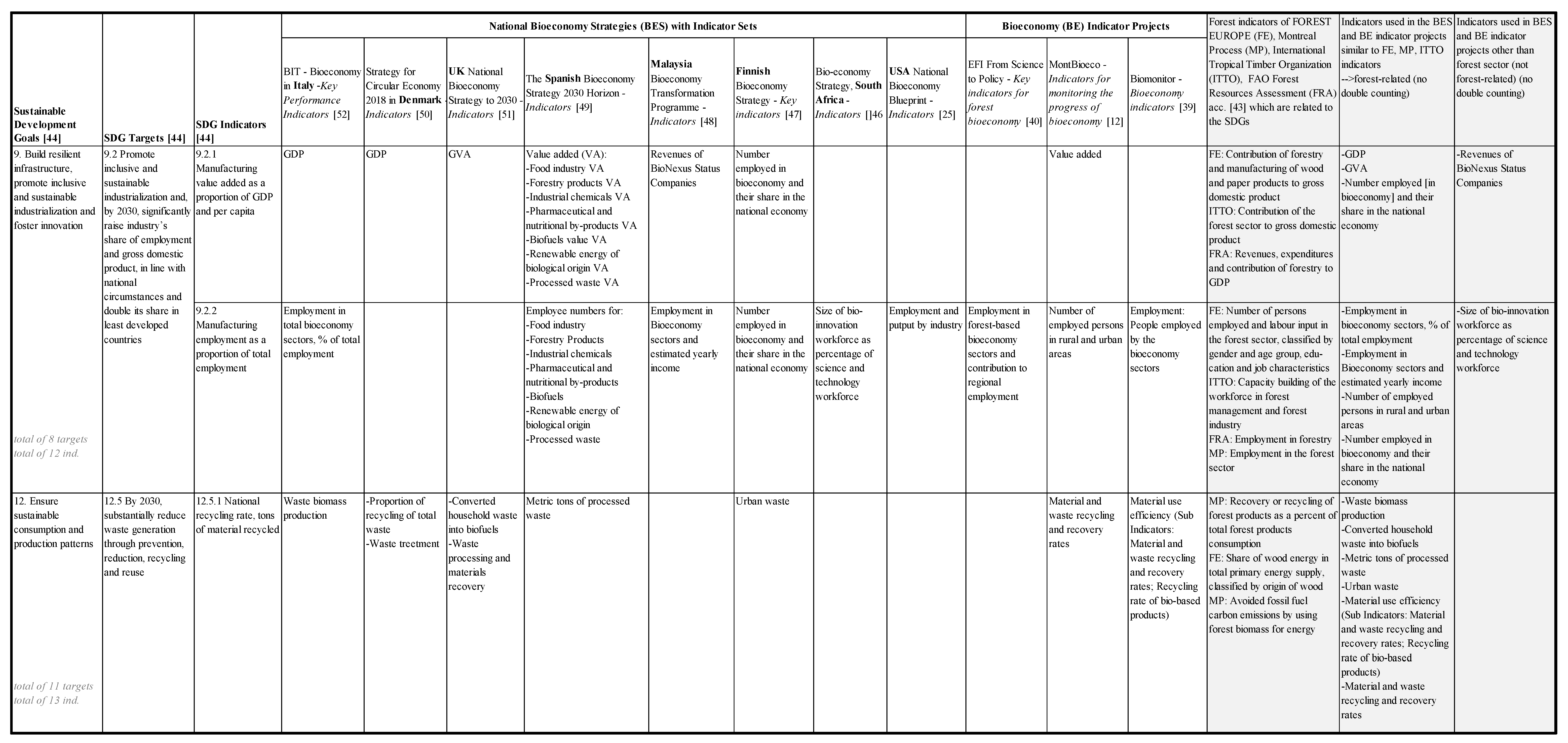
References
- World Commission on Environment and Development (WCED). Our Common Future; Oxford University Press: Oxford, UK, 1987. [Google Scholar]
- United Nations. Report of the World Summit on Sustainable Development. Johannesburg, South Africa, 26 August-4 September 2002. A/CONF.199/20; United Nations: New York, NY, USA, 2002; Available online: https://digitallibrary.un.org/record/478154 (accessed on 16 November 2019).
- United Nations. Transforming our world: The 2030 Agenda for Sustainable Development. Resolution Adopted by the General Assembly on 25 September 2015. In A/RES/70/1; United Nations: New York, NY, USA, 2015; Available online: https://www.un.org/ga/search/view_doc.asp?symbol=A/RES/70/1&Lang=E (accessed on 16 November 2019).
- Caradonna, J.L. Sustainability: A History; Oxford University Press: New York, NY, USA, 2014. [Google Scholar]
- Linser, S. Critical Analysis of the Basics for the Assessment of Sustainable Development by Indicators; Freiburger Forstliche Forschung, Band 17; Forstl. Versuchs- und Forschungsanst: Freiburg, Germany, 2002; ISBN 3-933548-17-9. [Google Scholar]
- Williams, C.C.; Millington, A.C. The diverse and contested meanings of sustainable development. Geogr. J. 2004, 170, 99–104. [Google Scholar] [CrossRef]
- United Nations. About the Sustainable Development Goals. 2019. Available online: https://www.un.org/sustainabledevelopment/sustainable-development-goals/ (accessed on 11 November 2019).
- Janousková, S.; Hák, T.; Moldan, B. Global SDGs Assessments: Helping or Confusing Indicators? Sustainability 2018, 10, 1540. [Google Scholar] [CrossRef]
- Geoghegan, T. Post-2015: Framing a New Approach to Sustainable Development; IRF2015 Policy Paper; Independent Research Forum on a Post-2015 Sustainable Development Agenda: London, UK, 2013. [Google Scholar]
- Hák, T.; Janousková, S.; Moldan, B. Closing the sustainability gap: 30 years after “our Common Future”, society lacks meaningful stories and relevant indicators to make the right decisions and build public support. Ecol. Indic. 2018, 87, 193–195. [Google Scholar] [CrossRef]
- Lier, M.; Kärkkäinen, L.; Korhonen, K.T.; Packalen, T. Understanding the Regional Bioeconomy Settings and Competencies in 29 EU Regions in 11 EU Countries; Natural Resources and Bioeconomy Studies 88/2019; Natural Resources Institute: Helsinki, Finland, 2019; ISBN 978-952-326-608-7. [Google Scholar]
- Lier, M.; Aarne, M.; Kärkkäinen, L.; Korhonen, K.T.; Yli-Viikari, A.; Packalen, T. Synthesis on Bioeconomy Monitoring Systems in the EU Member States—Indicators for Monitoring the Progress of Bioeconomy (MontBioeco); Natural Resources and Bioeconomy Studies 38/2018; Natural Resources Institute: Helsinki, Finland, 2018; ISBN 978-952-326-608-7. [Google Scholar]
- Dietz, T.; Börner, J.; Förster, J.J.; von Braun, J. Governance of the Bioeconomy: A Global Comparative Study of National Bioeconomy Strategies. Sustainability 2018, 10, 3190. [Google Scholar] [CrossRef]
- German Bioeconomy Council. Bioeconomy Policy (Part III) Update Report of National Strategies Around the World; Office of the Bioeconomy Council: Bonn, Germany, 2018; p. 124. Available online: https://biooekonomierat.de/fileadmin/Publikationen/berichte/GBS_2018_Bioeconomy-Strategies-around-the_World_Part-III.pdf (accessed on 19 November 2019).
- Gawel, E.; Pannicke, N.; Hagemann, N. A Path Transition towards a Bioeconomy—The Crucial Role of Sustainability. Sustainability 2019, 11, 3005. [Google Scholar] [CrossRef]
- European Commission. A sustainable bioeconomy for Europe: Strengthening the connection between economy, society and the environment. In Updated Bioeconomy Strategy. European Commission Directorate-General for Research and Innovation Unit F—Bioeconomy; Publications Office of the European Union: Luxembourg, 2018; p. 105. ISBN 978-92-79-94145-0. [Google Scholar] [CrossRef]
- European Commission. A sustainable bioeconomy for Europe: Strengthening the connection between economy, society and the environment. In COM (2018) 673 Final; European Commission: Brussels, Belgium, 2018. [Google Scholar]
- European Commission. The European Green Deal. Communication from the Commission to the European Parliament, the European Council, the Council, The European Economic and Social Committee and the Committee of the Regions. In COM (2019) 640 Final; European Commission: Brussels, Belgium, 2019; Available online: https://eur-lex.europa.eu/legal-content/EN/TXT/?qid=1576150542719&uri=COM%3A2019%3A640%3AFIN (accessed on 10 February 2020).
- European Commission. Future of the Common Agricultural Policy. Available online: https://ec.europa.eu/info/food-farming-fisheries/key-policies/common-agricultural-policy/future-cap_en (accessed on 19 January 2020).
- European Commission. Safeguarding Nature—EU 2030 Biodiversity Strategy. Available online: https://ec.europa.eu/info/law/better-regulation/initiatives/ares-2019-7908307_en (accessed on 19 January 2020).
- Hetemäki, L.; Hanewinkel, M.; Muys, B.; Ollikainen, M.; Palahi, M.; Trasobares, A. Leading the Way to a European Circular Bioeconomy Strategy; From Science to Policy 5; European Forest Institute: Joensuu, Finland, 2017; ISBN 978-952-5980-39-4. [Google Scholar]
- M’barek, R.; Philippidis, G.; Ronzon, T. Alternative Global Transition Pathways to 2050: Prospects for the Bioeconomy—An application of the MAGNET model with SDG insights. JRC Technical Report EUR 29862; Publications Office of the European Union: Luxembourg, 2019; ISBN 978-92-76-11335-5. [Google Scholar] [CrossRef]
- Puelzl, H.; Ramcilovic-Suominen, S. Sustainable development—A ‘selling point’ of the emerging EU bioeconomy policy framework? J. Clean. Prod. 2018, 172, 4170–4180. [Google Scholar]
- European Commission. Innovating for Sustainable Growth: A Bioeconomy for Europe. In COM (2012) 60 Final; European Commission: Brussels, Belgium, 2012. [Google Scholar]
- The White House. National Bioeconomy Blueprint; The White House: Washington, WA, USA, 2012.
- Global Bioeconomy Summit. Making Bioeconomy Work for Sustainable Development; Communique: Berlin, Germany, 2015; Available online: https://gbs2015.com/fileadmin/gbs2015/Downloads/Communique_final.pdf (accessed on 2 January 2020).
- Global Bioeconomy Summit. Conference Report; Global Bioeconomy Summit: Berlin, Germany, 2018; Available online: https://gbs2018.com/fileadmin/gbs2018/GBS_2018_Report_web.pdf (accessed on 2 January 2020).
- World Bioeconomy Forum. Available online: http://www.wcbef.com/ (accessed on 12 January 2020).
- International Bioeconomy Forum 2019. Available online: https://www5.agr.gc.ca/eng/science-and-innovation/international-engagement/international-bioeconomy-forum/?id=1552307410662 (accessed on 10 January 2020).
- European Bioeconomy Scene. Conference Outcome Report; European Bioeconomy Scene: Helsinki, Finland, 2019; Available online: https://www.bioeconomy.fi/wp-content/uploads//2019/09/Conference-Outcome-Report-EUBioScene19.pdf (accessed on 2 January 2020).
- United Nations. Circular Economy for the SDGs: From Concept to Practice. General Assembly and ECOSOC Joint Meeting Draft Concept. 2019. Available online: https://www.un.org/en/ga/second/73/jm_conceptnote.pdf (accessed on 11 November 2019).
- OECD. Meeting Policy Challenges for a Sustainable Bioeconomy; OECD: Paris, France, 2018. [Google Scholar] [CrossRef]
- Zeug, W.; Bezama, A.; Moesenfechtel, U.; Jähkel, A.; Thrän, D. Stakeholders’ Interests and Perceptions of Bioeconomy Monitoring Using a Sustainable Development Goal Framework. Sustainability 2019, 11, 1511. [Google Scholar] [CrossRef]
- Bracco, S.; Tani, A.; Çalıcıoğlu, Ö.; Gomez San Juan, M.; Bogdanski, A. Indicators to Monitor and Evaluate the Sustainability of Bioeconomy. Overview and a Proposed Way Forward; FAO Working Paper 77; FAO: Rome, Italy, 2019; ISBN 978-92-5-131796-9. [Google Scholar]
- Linser, S.; Wolfslehner, B.; Gritten, D.; Rasi, R.; Johnson, S.; Bridge, S.; Payn, T.; Prins, K.; Robertson, G. 25 Years of Criteria and Indicators for Sustainable Forest Management—Have they made a difference? Forests 2018, 9, 578. [Google Scholar] [CrossRef]
- Wolfslehner, B.; Linser, S.; Pülzl, H.; Bastrup-Birk, A.; Camia, A.; Marchetti, M. Monitoring and assessing the sustainable forest based-bioeconomy. In Towards a Sustainable European Forest-Based Bioeconomy—Assessment and the Way Forward; What Science Can Tell Us. 8; Winkel, G., Ed.; European Forest Institute: Joensuu, Finland, 2017; pp. 122–132. ISBN 978-952-5980-37-0. [Google Scholar]
- Giuntoli, J.; Robert, N.; Ronzon, T.; Sanchez Lopez, J.; Follador, M.; Girardi, I.; Barredo Cano, J.; Borzacchiello, M.; Sala, S.; M’Barek, R.; et al. Building a Monitoring System for the EU Bioeconomy. EUR 30064 EN; Publications Office of the European Union: Luxembourg, 2020; ISBN 978-92-76-15385-6. [Google Scholar] [CrossRef]
- European Commission. Review of the 2012 European Bioeconomy Strategy; Publications Office of the European Union: Luxembourg, 2017; ISBN 978-92-79-77541-3. [Google Scholar] [CrossRef]
- Kardung, M.; Costenoble, O.; Dammer, L.; Delahaye, R.; Lovric, M.; van Leeuwen, M.; M’Barek, R.; van Meijl, H.; Piotrowski, S.; Ronzon, T.; et al. Biomonitor Project D1.1: Framework for Measuring Size and Development of Bioeconomy with a List and Detailed Description of Bioeconomy Indicators, Measures, and Data Requirements. Issued 05/2019. Available online: http://biomonitor.eu/wp-content/uploads/2019/10/BioMonitor_Deliverable_1.1_Update_1.pdf (accessed on 13 June 2019).
- Wolfslehner, B.; Linser, S.; Pülzl, H.; Bastrup-Birk, A.; Camia, A.; Marchetti, M. Forest Bioeconomy—A New Scope for Sustainability Indicators; From Science to Policy 4; European Forest Institute: Joensuu, Finland, 2016; ISBN 978-952-5980-29-5. [Google Scholar] [CrossRef]
- Linser, S.; Wolfslehner, B.; Asmar, F.; Bridge, S.R.J.; Gritten, D.; Guadalupe, V.; Jafari, M.; Johnson, S.; Laclau, P.; Robertson, G. 25 Years of Criteria and Indicators for Sustainable Forest Management: Why Some Intergovernmental C & I Processes Flourished While Others Faded. Forests 2018, 9, 515. [Google Scholar] [CrossRef]
- Baycheva, T.; Inhaizer, H.; Lier, M.; Prins, K.; Wolfslehner, B. Implementing Criteria and Indicators for Sustainable Forest Management in Europe; European Forest Institute: Joensuu, Finland, 2013; ISBN 978-952-5980-04-2. [Google Scholar]
- Linser, S.; O’Hara, P. Guidelines for the Development of a Criteria and Indicator Set for Sustainable Forest Management. ECE/TIM/DP/73; United Nations: Geneva, Switzerland, 2019; ISBN 978-92-1-117190-7. [Google Scholar] [CrossRef]
- United Nations. Global Indicator Framework for the Sustainable Development Goals and targets of the 2030 Agenda for Sustainable Development. In A/RES/71/313 E/CN.3/2018/2; United Nations: New York, NY, USA, 2018. [Google Scholar]
- United Nations Economic and Social Council. Report of the Inter-Agency and Expert Group on Sustainable Development Goal Indicators. In E/CN.3/2019/2; United Nations: New York, NY, USA, 2018. [Google Scholar]
- Republic of South Africa. The Bioeconomy Strategy; Department of Science and Technology of the Republic of South Africa: Pretoria, South Africa, 2013; ISBN 978-1-919966-06-9.
- TYÖ (Ministry of Employment and the Economy). Sustainable Growth from Bioeconomy—The Finnish Bioeconomy Strategy; Edita Prima Ltd.: Helsinki, Finland, 2014.
- MOSTI (Ministry of Science, Technology and Innovation). Bioeconomy Transformation Programme. Enriching the Nation, Securing the Future; MOSTI: Putrajaya, Malaysia, 2015.
- de Espana, G. The Spanish Bioeconomy Strategy. 2030 Horizon; Ministerio de Economia y Competitividad and Secretaria de Estado de Investigacion, Desarrollo e Innovacion: Madrid, Spain, 2016.
- The Danish Government. Strategy for Circular Economy; Danish Ministry of Environment and Food: Copenhagen, Denmark, 2018; ISBN 978-87-93635-82-1.
- HM Government. Growing the Bioeconomy. In Improving Lives and Strengthening Our Economy: A National Bioeconomy Strategy to 2030; Crown OGL: London, UK, 2018. [Google Scholar]
- Government of Italy. BIT—The Bioeconomy Strategy of ITALY. A Unique Opportunity to Reconnect the Economy, Society and the Environment. 2018. Available online: https://gbs20.org/fileadmin/gbs2020/documents/BE_in_Italy_update.pdf (accessed on 8 July 2019).
- Iriarte, L.; Fritsche, U. S2BIOM Deliverable 5.4—Consistent Cross-Sectoral Sustainability Criteria & Indicators. S2BIOM Project. Delivery of Sustainable Supply of Non-Food Biomass to Support a “Resource-Efficient” Bioeconomy in Europe. 2015. Available online: https://www.s2biom.eu/images/Publications/D5.4_S2Biom_CrossSectoral_Sustainability_Indicators_Final.pdf (accessed on 19 July 2019).
- OECD. Green Growth Indicators 2017. In OECD Green Growth Studies; OECD: Paris, France, 2017. [Google Scholar] [CrossRef]
- Bauer, M.W. Classical Content Analysis: A Review. In Qualitative Researching with Text, Image and Sound—A Practical Handbook for Social Research, 1st ed.; Bauer, M.W., Gaskell, G., Eds.; SAGE Publishing: London, UK, 2000; pp. 131–151. ISBN 9780761964803. [Google Scholar]
- Flick, U. Qualitative Sozialforschung, 3rd ed.; Rowohlt Taschenbuch Verlag: Reinbek, Germany, 2010; ISBN 978-3-499-55694-4. [Google Scholar]
- Puelzl, H.; Giurca, A.; Kleinschmit, D.; Arts, B.; Mustalahti, I.; Sergent, A.; Secco, L.; Pettenella, D.; Brukas, V. The role of forests in bioeconomy strategies at the domestic and EU level. In What Scienec Can Tell Us 8; European Forest Institute: Joensuu, Finland, 2017; ISBN 978-952-5980-41-7. [Google Scholar]
- Wood, R.; Stadler, K.; Bulavskaya, T.; Lutter, S.; Giljum, S.; De Koning, A.; Kuenen, J.; Schütz, H.; Acosta-Fernández, J.; Usubiaga, A.; et al. Global Sustainability Accounting—Developing EXIOBASE for Multi-Regional Footprint Analysis. Sustainability 2015, 7, 138–163. [Google Scholar] [CrossRef]
- Forest Europe. State of Europe’s Forests Report 2015; Forest Europe Liaison Unit: Madrid, Spain, 2015. [Google Scholar]
- Lexas: Küstenlänge Aller Länder. Available online: https://www.laenderdaten.de/geographie/kuestenlaenge.aspx (accessed on 15 January 2020).
- FAO. Global Forest Resources Assessment 2015. In Country Report Malaysia; FAO: Rome, Italy, 2015. [Google Scholar]
- FAO. Keeping an Eye on SDG 15—Working with Countries to Measure Indicators for Forests and Mountains; FAO: Rome, Italy, 2013; Available online: http://www.fao.org/3/a-i7334e.pdf (accessed on 1 June 2019).
- Heimann, T. Bioeconomy and Sustainable Development Goals (SDGs): Does the bioeconomy support the achievement of the SDGs? Earth’s Future 2018, 7, 43–57. [Google Scholar] [CrossRef]
- Hansen, E.N. Responding to the Bioeconomy: Business Model Innovation in the Forest Sector. In Environmental Impacts of Traditional and Innovative Forest-based Bioproducts. Environmental Footprints and Eco-design of Products and Processes; Kutnar, A., Muthu, S., Eds.; Springer: Singapore, 2016; ISBN 978-981-10-0653-1. [Google Scholar]
- Hazarika, R.; Jandl, R. The Nexus between the Austrian Forestry Sector and the Sustainable Development Goals: A Review of the Interlinkages. Forests 2019, 10, 205. [Google Scholar] [CrossRef]
- Katila, P.; Pierce Colfer, C.; De Jong, W.; Galloway, G.; Pacheco, P.; Winkel, G. Introduction. In Sustainable Development Goals: Their Impacts on Forests and People; Katila, P., Pierce Colfer, C., De Jong, W., Galloway, G., Pacheco, P., Winkel, G., Eds.; Cambridge University Press: Cambridge, UK, 2019; ISBN 9781108765015. [Google Scholar] [CrossRef]
- Tegegne, Y.T.; Cramm, M.; Van Brusselen, J.; Linhares-Juvenal, T. Forest Concessions and the United Nations Sustainable Development Goals: Potentials, Challenges and Ways Forward. Forests 2019, 10, 45. [Google Scholar] [CrossRef]
- Köhl, M.; Ehrhart, H.-P.; Knauff, M.; Neupane, P.R. A viable indicator approach for assessing sustainable forest management in terms of carbon emissions and removals. Ecol. Ind. 2020, 111, 106057. [Google Scholar] [CrossRef]
- European Commission. Sustainable Development in the European Union—Overview of Progress Towards the SDGs in an EU Context—2018 Edition; Publications Office of the European Union: Luxembourg, 2018; ISBN 978-92-79-88745-1. [Google Scholar] [CrossRef]
- EC Horizon 2020—Work Programme 2018-2020 Food Security, Sustainable Agriculture and Forestry, Marine, Maritime and Inland Water Research and the Bioeconomy. Available online: https://ec.europa.eu/programmes/horizon2020/sites/horizon2020/files/food_h2020_wp_2018-2020_draft.pdf (accessed on 6 March 2020).
- Ministry of Agriculture and Forestry of Finland. Oikeudenmukaisuuden Rooli Biotaloutta Koskevissa Ratkaisuissa (The role of SDG16 in Bioeconomy Solutions). Available online: https://mmm.fi/biotaloushankeartikkeli/-/asset_publisher/oikeudenmukaisuuden-rooli-biotaloutta-koskevissa-ratkaisuissa (accessed on 6 March 2020).
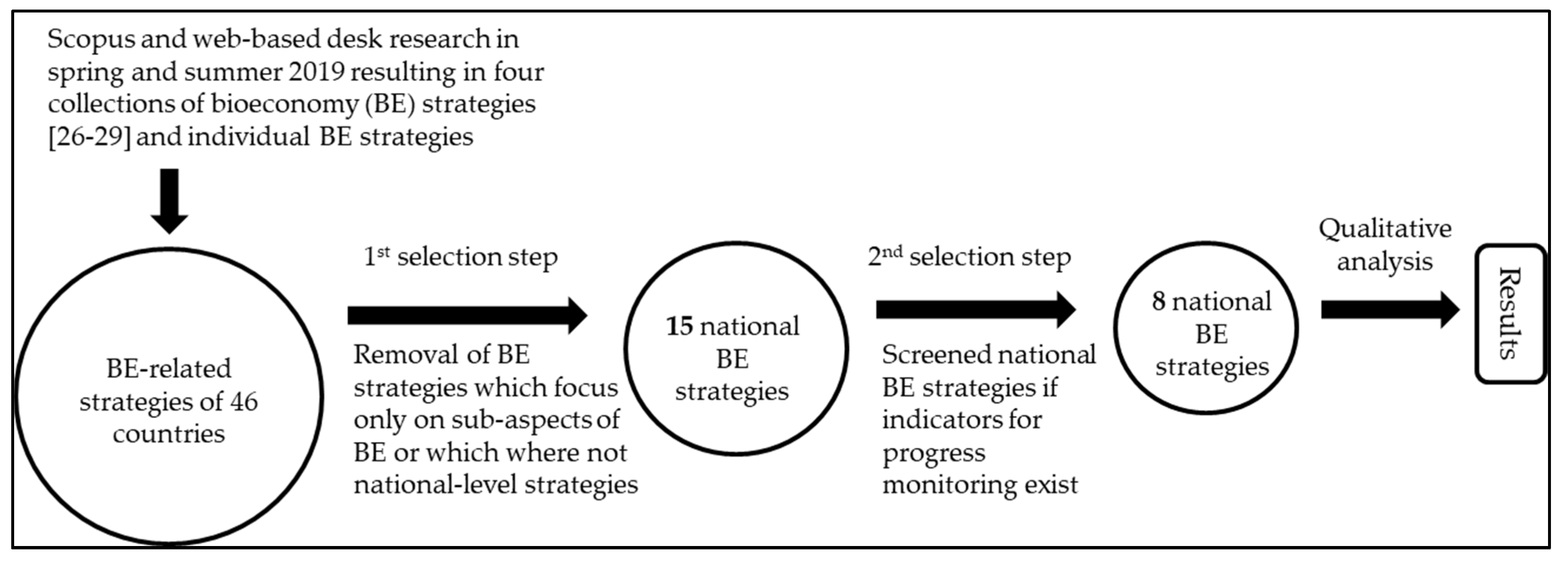
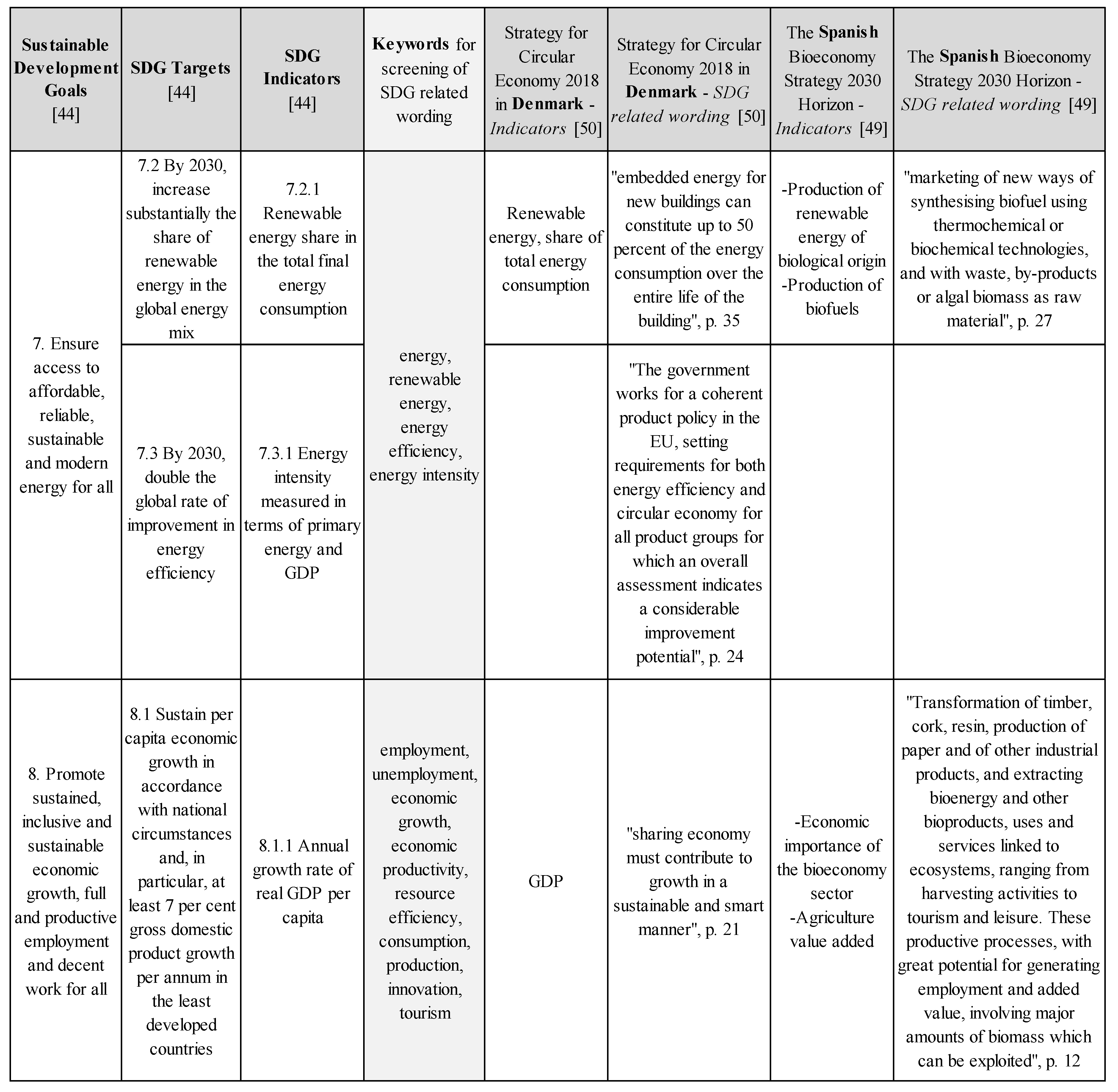
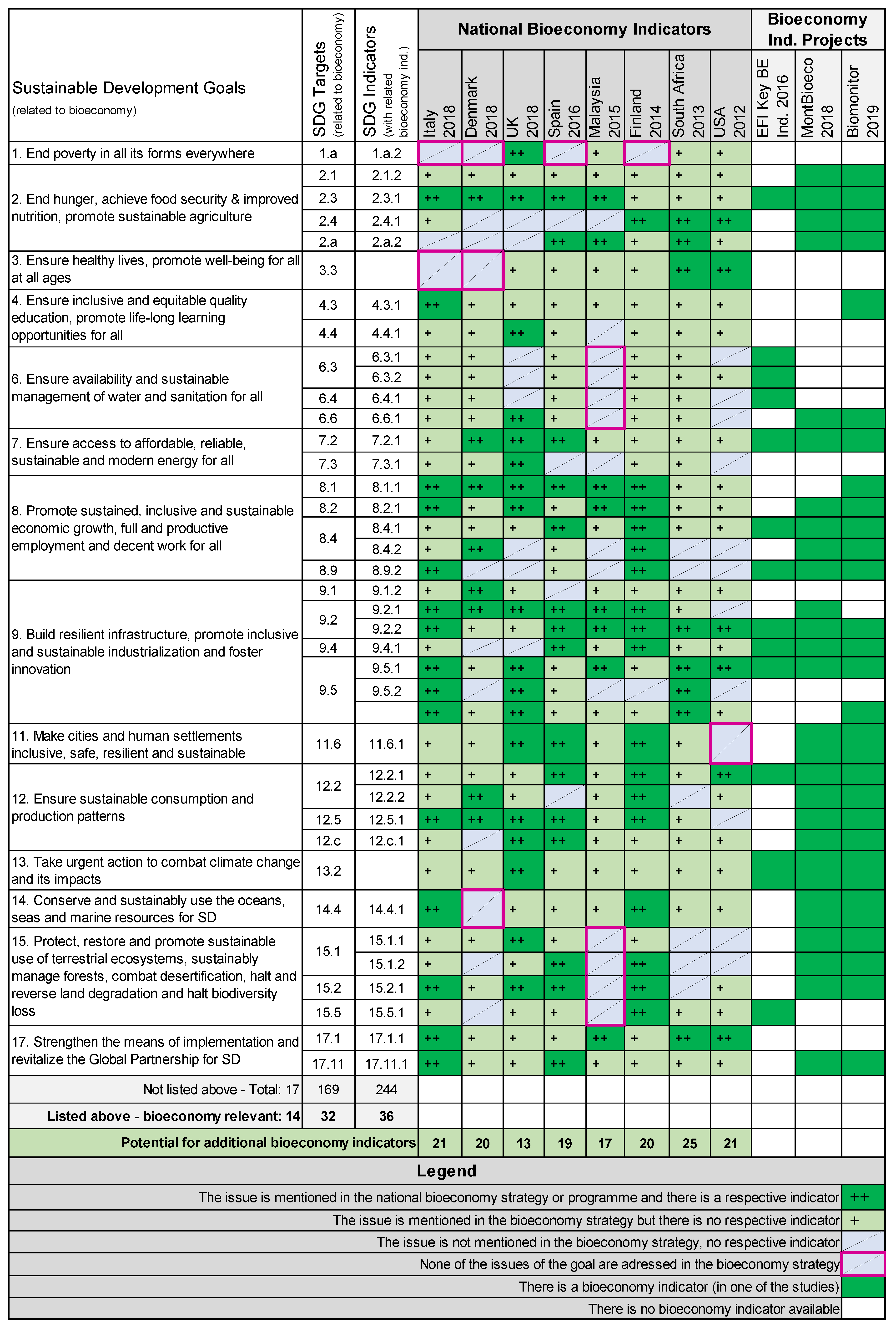
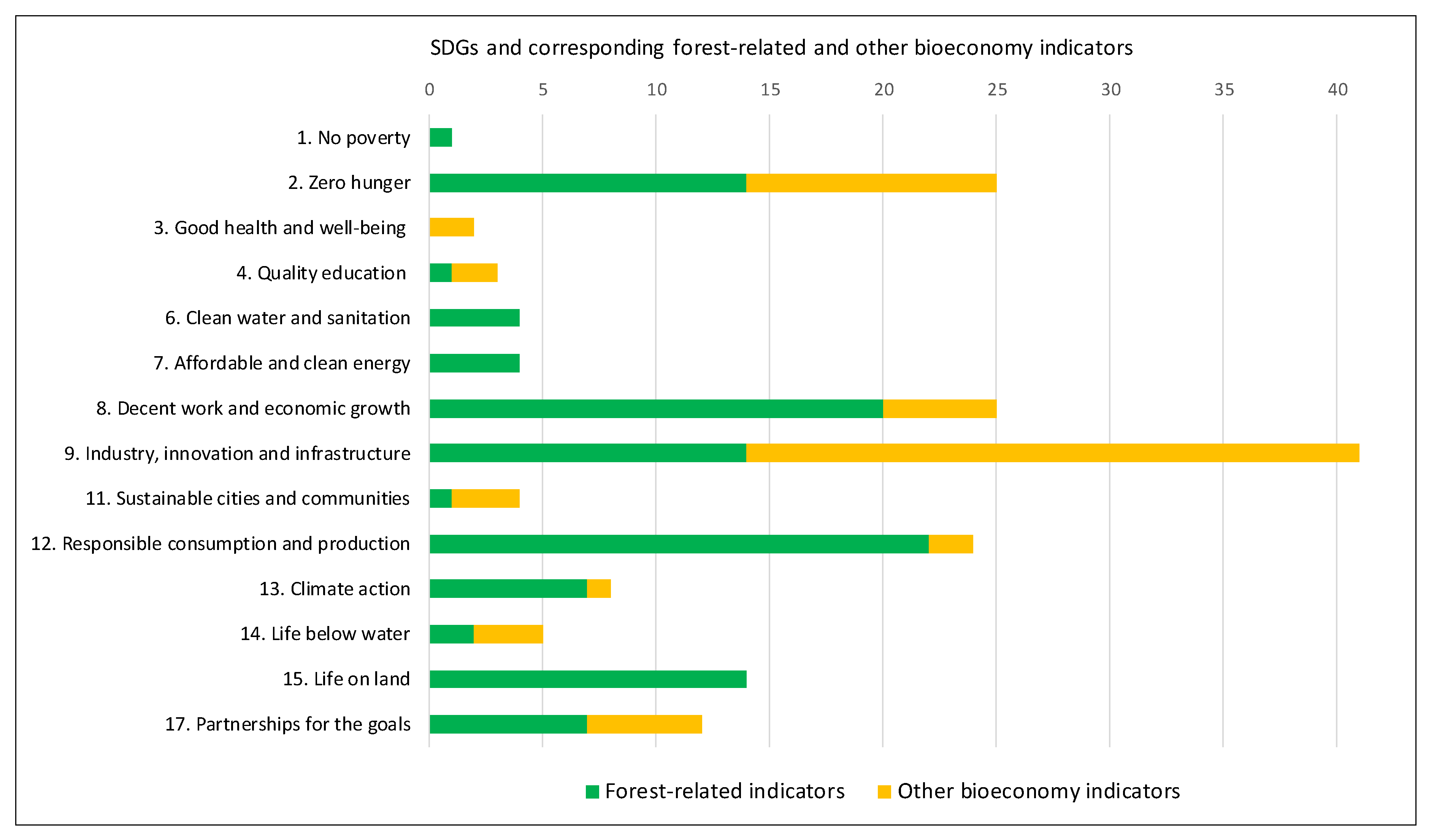
| Year of Publication | Country | National Bioeconomy Strategy |
|---|---|---|
| 2012 | USA | National Bioeconomy Blueprint—Indicators [25] |
| 2013 | South Africa | Bio-economy Strategy, South Africa—Indicators of critical factors [46] |
| 2014 | Finland | Finnish Bioeconomy Strategy—Key indicators [47] |
| 2015 | Malaysia | Bioeconomy Transformation Programme— Bioeconomy Contribution Index [48] |
| 2016 | Spain | Spanish Bioeconomy Strategy 2030 Horizon—Evaluation Index [49] |
| 2018 | Denmark | Strategy for Circular Economy—Indicators [50] |
| 2018 | United Kingdom | A national bioeconomy strategy to 2030—Indicators [51] |
| 2018 | Italy | A new bioeconomy strategy for a sustainable Italy— Key Performance Indicators [52] |
| Sustainable Development Goals (Short Text Versions) | Keywords Used for Screening of SDG-Related Wording and Indicators |
|---|---|
| 1. No poverty | Poverty, poverty reduction, tenure, access, investment |
| 2. Zero hunger | Hunger, food insecurity, food security, nutrition, agriculture, productivity, production, farmers, technology |
| 3. Good health and well-being | Well-being, human, health, nutrition, diseases |
| 4. Quality education | Education, training, learning, research, technology, inclusivity, skills |
| 5. Gender equality | Gender equality, equal rights, empowerment of women |
| 6. Clean water and sanitation | Water, water resource, pollution, reduced water consumption, water efficiency, wastewater |
| 7. Affordable and clean energy | Energy, renewable energy, energy efficiency, energy intensity |
| 8. Decent work and economic growth | Employment, unemployment, economic growth, economic productivity, resource efficiency, consumption, production, innovation, tourism |
| 9. Industry, innovation and infrastructure | Infrastructure, industrialization, innovation, transport, GDP, value added, employment, resource efficiency, CO2 emission, research and development expenditures, researcher |
| 10. Reduced inequalities | Equal opportunity |
| 11. Sustainable cities and communities | Communities, cities, waste, waste processing |
| 12. Responsible consumption and production | Production, consumption, sustainable management, natural resources, efficiency, value added, GDP, waste, recycling, reuse, fuel, fossil-fuel subsidies |
| 13. Climate action | Climate change, climate impacts, carbon |
| 14. Life below water | Oceans, seas, marine resources, inland water, fish stocks, fishing, overfishing |
| 15. Life on land | Terrestrial ecosystems, forest, afforestation, reforestation, desertification, degradation, restoration, sustainable use, sustainable forest management, biomass, biodiversity, conservation, protected areas, certification |
| 16. Peace, justice, and strong institutions | Peace, justice, institutions, rule of law, public access to information |
| 17. Partnership for the goals | International cooperation, revenue, exports |
| Sustainable Development Goals (Short text versions) | Italy [52] | UN [31] | Global BE Summit [27] | Authors’ Findings | Why Can the Bioeconomy Help to Achieve SDGs? |
|---|---|---|---|---|---|
| 1. No poverty | x | The increasing demand for bioeconomy products may lead to increased employment and thus higher household income, therefore reducing poverty [63]. | |||
| 2. Zero hunger | x | x | x | In applying innovative production and processing technologies, sustainable agriculture may lead to improved food security and therefore to improved nutrition [17,27,37]. | |
| 3. Good health and well-being | x | x | The bioeconomy may improve living standards and human well-being through e.g., bio-based pharmaceuticals [27]. | ||
| 4. Quality education | x | Access to equal education, training and skills may benefit growing bioeconomy labor markets [17,37]. | |||
| 6. Clean water and sanitation | x | x | In the bioeconomy, wastewater treatment is a renewable source of energy, fertilizers, and chemicals [16]. | ||
| 7. Affordable and clean energy | x | x | x | x | Sustainable energy reduces dependence on non-renewable and unsustainable resources; it may help to boost the development of society [17]. |
| 8. Decent work and economic growth | x | x | x | A sustainable and circular bioeconomy may result in economic growth and therefore benefit society as a whole [63]. | |
| 9. Industry, innovation and infrastructure | x | x | Infrastructure investment, sustainable industrialization and the application of innovation is key to bioeconomy development [27]. | ||
| 11. Sustainable cities and communities | x | x | Cities may become major circular bioeconomy hubs with optimized waste processing and materials recovery [16]. | ||
| 12. Responsible consumption and production | x | x | x | x | All bioeconomy sectors depend on sustainable production and may pave the way for a changing consumption behavior [27,37]. |
| 13. Climate action | x | x | x | The bioeconomy as a whole may contribute to the mitigation of climate change through “negative emissions” and carbon sinks [27,37]. | |
| 14. Life below water | x | x | x | x | The sustainable use, protection and restoration of marine and inland water ecosystems is a precondition of a bioeconomy [17,27]. |
| 15. Life on land | x | x | x | x | The sustainable use, protection and restoration of terrestrical ecosystems is a precondition of a bioeconomy [17,37]. |
| 17. Partnership for the goals | x | A bioeoconomy may provide opportunities for new business models and expanding global markets [64]. |
© 2020 by the authors. Licensee MDPI, Basel, Switzerland. This article is an open access article distributed under the terms and conditions of the Creative Commons Attribution (CC BY) license (http://creativecommons.org/licenses/by/4.0/).
Share and Cite
Linser, S.; Lier, M. The Contribution of Sustainable Development Goals and Forest-Related Indicators to National Bioeconomy Progress Monitoring. Sustainability 2020, 12, 2898. https://doi.org/10.3390/su12072898
Linser S, Lier M. The Contribution of Sustainable Development Goals and Forest-Related Indicators to National Bioeconomy Progress Monitoring. Sustainability. 2020; 12(7):2898. https://doi.org/10.3390/su12072898
Chicago/Turabian StyleLinser, Stefanie, and Markus Lier. 2020. "The Contribution of Sustainable Development Goals and Forest-Related Indicators to National Bioeconomy Progress Monitoring" Sustainability 12, no. 7: 2898. https://doi.org/10.3390/su12072898
APA StyleLinser, S., & Lier, M. (2020). The Contribution of Sustainable Development Goals and Forest-Related Indicators to National Bioeconomy Progress Monitoring. Sustainability, 12(7), 2898. https://doi.org/10.3390/su12072898






